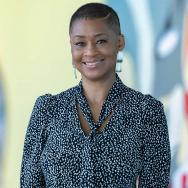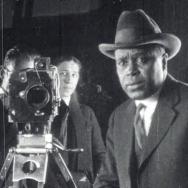For four years, Prof. Jacqueline Stewart, AM’93, PhD’99, has applied her knowledge of film as a scholar and archivist to educate a wider audience. She served first as the chief artistic and programming officer and then as director and president at the Academy Museum of Motion Pictures. This fall, she returns to UChicago to teach and work on her own scholarship.
During her time in Los Angeles, this specialist in Black and silent cinema continued to serve as a host for Turner Classic Movies—a tenure that began in September 2019. Adding to her laurels, Stewart received a MacArthur Fellowship in 2021.
“It turned out to be very helpful to have such a demanding role when I received the MacArthur Fellowship,” said Stewart, professor in the Department of Cinema and Media Studies and the College at UChicago. “Since I was working so intensely at the museum, I could not start any individual research projects. I now have a large file of ideas, leads and contacts that I want to begin researching more deeply. I know my next projects will explore a wider range of sources and audiences, which I probably would not have considered before my Academy Museum experience.”
Stewart has published several influential books, including: Migrating to the Movies: Cinema and Black Urban Modernity (2005) and L.A. Rebellion: Creating a New Black Cinema (2015), co-edited with Jan-Christopher Horak and UChicago colleague Assoc. Prof. Allyson Nadia Field. She founded the South Side Home Movie Project in 2005, which collects, preserves and hosts screenings of small-gauge amateur films by residents of Chicago’s South Side. Housed at UChicago’s Arts + Public Life initiative, the project digitizes and makes these unique films available to educators, artists and the general public.
In this edited Q&A, Stewart discusses her experiences at the Academy Museum of Motion Pictures, learning to engage with a wider audience and how her perspective has changed.
How did your experience as a scholar and film historian support the work you did at the Academy Museum of Motion Pictures?
Throughout my time at UChicago, I’ve sought to provide opportunities to share scholarship with the public, from programming film series at Doc Films as a graduate student to serving as Faculty Director of the Gray Center for Arts and Inquiry and the Arts and Public Life initiative, to founding the South Side Home Movie Project. I brought these experiences to the Academy Museum, where I initially led the curatorial, programming, education and publication teams, and created a digital content team, in the lead-up to its opening in September 2021. As we presented the Museum’s first exhibitions, screenings, youth and family programs, symposia, exhibition catalogues, audio tours, web content, videos and a podcast, I approached this work with the aim of combining scholarly rigor with accessibility to diverse visitors. I’m proud that we created an institution that inspires audiences of all backgrounds to reach beyond their comfort zones to learn more than they expected.
Through the years (2020 to 2024) you spent at the Academy Museum, what are the three most relevant things that you learned from the experience?
First, I learned that cinema is at once a medium that brings people together—because everyone has a favorite film or moviegoing experience—and a topic that incites intense debate and disagreement. For example, there are strongly divergent views about “cancelled” artists, legacies of misrepresentation and ongoing inequities in the film industry. Instead of trying to resolve this seeming contradiction of celebration vs. critique, my colleagues and I leaned into it. We created platforms for sharing stories and engaging in respectful discussion that I hope will, in the long run, demonstrate how central cinema is to all areas of cultural conversation.
Second, I realized that the Academy of Motion Picture Arts and Sciences is far more than what we see annually on the Oscars broadcast. It is an almost century-old institution that has been building archives of film-related materials since it was founded and has fostered the future of filmmaking, film workers and film culture. The Academy is a membership organization of 10,000-plus filmmakers, as well as a team of dedicated staff.
Third, I learned a tremendous amount about how to foster collaboration, particularly when creating new, public facing work. During the past four years, I’ve developed my skills as a manager, finding ways to communicate the museum’s goals with clarity and passion internally to staff and externally to a myriad of partners and stakeholders. Some of our ideas worked, some didn’t. But overall, it was illuminating to be in an environment where colleagues from so many different fields – curation, exhibition design, fundraising, safety, marketing, retail, preservation, programming, media relations, community engagement and more – supported each other in experimenting with new ideas.
Has your work at the Academy Museum changed your perspective as a scholar and professor at UChicago?
I had the extraordinary opportunity to work directly with filmmakers of all disciplines—actors, writers, directors, costume designers, casting directors, sound editors, production designers, documentarians, animators and more. Hearing these accomplished artists talk about their work and the histories of their fields has inspired me to think differently about the materials I will share in my teaching and writing. These first-hand practitioner perspectives don’t displace the interpretive work that scholars perform. But I am thinking a lot about how their reflections complicate and deepen the critical work that I’ve done in the past, and how it can inform my scholarship and mentorship of students going forward.
At the Academy Museum, you reached a much wider audience than at UChicago. Did that change your perspective on the history of filmmaking and filmmakers?
When thinking about the large and diverse audiences that engage with the Academy Museum’s content in person and online, as well as the audiences I speak to as a host on Turner Classic Movies, I keep the importance of rigorous scholarship top of mind. Fundamentally, my perspective on the significance of film history has not changed. However, I’ve expanded my ability to translate film historical insights to different audiences. And I have seen that there are many distinct types of film knowledge—filmmakers, archivists, critics, fans —which can speak to each other more productively.

